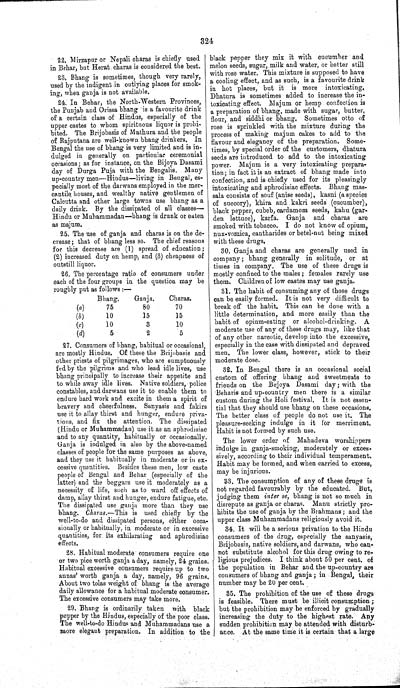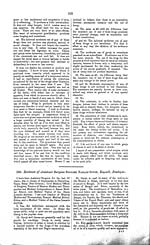Medicine - Drugs > Report of the Indian Hemp Drugs Commission, 1894-1895 > Volume IV
(338) Volume 4, Page 324
Thumbnail gallery: Grid view | List view

324
22. Mirzapur or
Nepali charas is chiefly used
in Behar, but Herat charas is considered the best.
23. Bhang is
sometimes, though very rarely,
used by the indigent in outlying places for smok-
ing, when ganja is not available.
24. In Behar, the
North-Western Provinces,
the Punjab and Orissa bhang is a favourite drink
of a certain class of Hindus, especially of the
upper castes to whom spirituous liquor is prohi-
bited. The Brijobasis of Mathura and the people
of Rajputana are well-known bhang drinkers. In
Bengal the use of bhang is very limited and is in-
dulged in generally on particular ceremonial
occasions; as for instance, on the Bijoya Dasami
day of Durga Puja with the Bengalis. Many
up-country men—Hindus—living in Bengal, es-
pecially most of the darwans employed in the mer-
cantile houses, and wealthy native gentlemen of
Calcutta and other large towns use bhang as a
daily drink. By the dissipated of all classes—
Hindu or Muhammadan—bhang is drunk or eaten
as majum.
25. The use of
ganja and charas is on the de-
crease; that of bhang less so. The chief reasons
for this decrease are (1) spread of education;
(2) increased duty on hemp, and (3) cheapness of
outstill liquor.
26. The percentage
ratio of consumers under
each of the four groups in the question may be
roughly put as follows:—
|
Bhang |
Ganja |
Charas |
|
|
(a) |
75 |
80 |
70 |
|
(b) |
10 |
15 |
15 |
|
(c) |
10 |
3 |
10 |
|
(d) |
5 |
2 |
5 |
27. Consumers of bhang,
habitual or occasional,
are mostly Hindus. Of these the Brijobasis and
other priests of pilgrimages, who are sumptuously
fed by the pilgrims and who lead idle lives, use
bhang principally to increase their appetite and
to while away idle lives. Native soldiers, police
constables, and darwans use it to enable them to
endure hard work and excite in them a spirit of
bravery and cheerfulness. Sanyasis and fakirs
use it to allay thirst and hunger, endure priva-
tions, and fix the attention. The dissipated
(Hindu or Muhammadan) use it as an aphrodisiac
and to any quantity, habitually or occasionally.
Ganja is indulged in also by the above-named
classes of people for the same purposes as above,
and they use it habitually in moderate or in ex-
cessive quantities. Besides these men, low caste
people of Bengal and Behar (especially of the
latter) and the beggars use it moderately as a
necessity of life, such as to ward off effects of
damp, allay thirst and hunger, endure fatigue, etc.
The dissipated use ganja more than they use
bhang. Charas.—This is used chiefly by the
well-to-do and dissipated persons, either occa-
sionally or habitually, in moderate or in excessive
quantities, for its exhilarating and aphrodisiac
effects.
28. Habitual
moderate consumers require one
or two pice worth ganja a day, namely, 24 grains.
Habitual excessive consumers require up to two
annas' worth ganja a day, namely, 96 grains.
About two tolas weight of bhang is the average
daily allowance for a habitual moderate consumer.
The excessive consumers may take more.
29. Bhang is
ordinarily taken with black
pepper by the Hindus, especially of the poor class.
The well-to-do Hindus and Muhammadans use a
more elegant preparation. In addition to the
black pepper they mix it
with cucumber and
melon seeds, sugar, milk and water, or better still
with rose water. This mixture is supposed to have
a cooling effect, and as such, is a favourite drink
in hot places, but it is more intoxicating.
Dhatura is sometimes added to increase the in-
toxicating effect. Majum or hemp confection is
a preparation of bhang, made with sugar, butter,
flour, and siddhi or bhang. Sometimes otto of
rose is sprinkled with the mixture during the
process of making majum cakes to add to the
flavour and elegancy of the preparation. Some-
times, by special order of the customers, dhatura
seeds are introduced to add to the intoxicating
power. Majum is a very intoxicating prepara-
tion; in fact it is an extract of bhang made into
confection, and is chiefly used for its pleasingly
intoxicating and aphrodisiac effects. Bhang mas-
sala consists of souf (anise seeds), kasni (a species
of succory), khira and kakri seeds (cucumber),
black pepper, cubeb, cardamom seeds, kahu (gar-
den lettuce), karfa. Ganja and charas are
smoked with tobacco. I do not know of opium,
nux-vomica, cantharides or betel-nut being mixed
with these drugs.
30. Ganja and
charas are generally used in
company; bhang generally in solitude, or at
times in company. The use of these drugs is
mostly confined to the males; females rarely use
them. Children of low castes may use ganja.
31. The habit of
consuming any of those drugs
can be easily formed. It is not very difficult to
break off the habit. This can be done with a
little determination, and more easily than the
habit of opium-eating or alcohol-drinking. A
moderate use of any of these drugs may, like that
of any other narcotic, develop into the excessive,
especially in the case with dissipated and depraved
men. The lower class, however, stick to their
moderate dose.
32. In Bengal there
is an occasional social
custom of offering bhang and sweetmeats to
friends on the Bejoya Dasami day; with the
Beharis and up-country men there is a similar
custom during the Holi festival. It is not essen-
tial that they should use bhang on these occasions.
The better class of people do not use it. The
pleasure-seeking indulge in it for merriment.
Habit is not formed by such use.
The lower order of
Mahadeva worshippers
indulge in ganja-smoking, moderately or exces-
sively, according to their individual temperament.
Habit may be formed, and when carried to excess,
may be injurious.
33. The consumption
of any of these drugs is
not regarded favourably by the educated. But,
judging them inter se, bhang is not so much in
disrepute as ganja or charas. Manu strictly pro-
hibits the use of ganja by the Brahmans; and the
upper class Muhammadans religiously avoid it.
34. It will be a
serious privation to the Hindu
consumers of the drug, especially the sanyasis,
Brijobasis, native soldiers, and darwans, who can-
not substitute alcohol for this drug owing to re-
ligious prejudices. I think about 50 per cent. of
the population in Behar and the up-country are
consumers of bhang and ganja; in Bengal, their
number may be 20 per cent.
35. The prohibition
of the use of these drugs
is feasible. There must be illicit consumption;
but the prohibition may be enforced by gradually
increasing the duty to the highest rate. Any
sudden prohibition may be attended with disturb-
ance. At the same time it is certain that a large
Set display mode to: Large image | Zoom image | Transcription
Images and transcriptions on this page, including medium image downloads, may be used under the Creative Commons Attribution 4.0 International Licence unless otherwise stated. ![]()
| India Papers > Medicine - Drugs > Report of the Indian Hemp Drugs Commission, 1894-1895 > Volume IV > (338) Volume 4, Page 324 |
|---|
| Permanent URL | https://digital.nls.uk/74552926 |
|---|---|
| Description | Evidence of Bengal witnesses. |
| Description | Volume 4: Evidence of witnesses from Bengal and Assam. |
|---|---|
| Attribution and copyright: |
|




